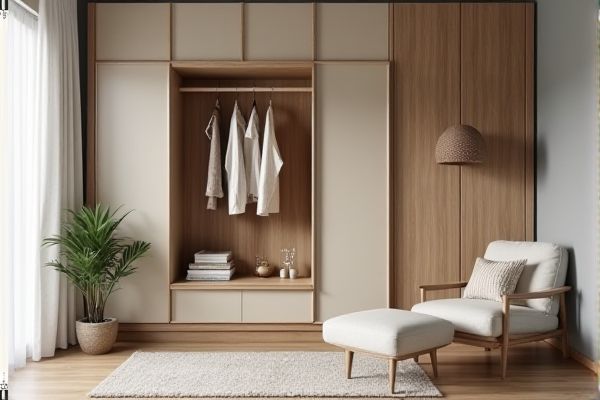
Wall-mounted closets maximize floor space and offer a sleek, modern look by attaching directly to walls, making them ideal for small rooms or minimalist designs. If you're weighing your options for storage solutions, discover which choice best suits Your space and style needs by reading the rest of the article.
Table of Comparison
| Feature | Wall-Mounted Closet | Freestanding Unit |
|---|---|---|
| Installation | Requires wall attachment; professional help recommended | Easy setup; no wall modification needed |
| Space Utilization | Maximizes floor space; ideal for small rooms | Consumes floor space; flexible placement |
| Stability | Highly stable when properly mounted | Stable but can tip if overloaded |
| Customization | Limited to wall size and structure | Varied sizes and styles available |
| Portability | Fixed; difficult to move once installed | Portable; easy to relocate |
| Cost | Usually higher due to installation | Generally more affordable |
| Durability | Durable if mounted on solid wall | Durability varies with material and design |
Introduction to Closet Storage Solutions
Wall-mounted closets maximize floor space by attaching directly to the wall, offering sleek storage ideal for smaller rooms or modern interiors. Freestanding closet units provide versatile, movable storage options that can be customized or relocated to fit varying needs and room layouts. Your choice impacts organization efficiency and room aesthetics, making it essential to consider space limitations and design preferences.
Wall-Mounted Closets: Features and Benefits
Wall-mounted closets maximize floor space by being securely attached to walls, offering a sleek, modern appearance ideal for small rooms and minimalist designs. These units often include customizable shelving and hanging options that adapt to your specific storage needs while keeping items easily accessible and organized. Installing a wall-mounted closet enhances room functionality and cleanliness by elevating storage off the floor, reducing dust accumulation and simplifying cleaning.
Freestanding Units: Overview and Advantages
Freestanding closet units offer flexibility in placement and easy relocation, making them ideal for renters or those who frequently rearrange their space. Their diverse styles and sizes accommodate various storage needs without the need for wall installation, preserving your walls from damage. You benefit from a portable, versatile storage solution that can adapt to changing room layouts and design preferences.
Space Optimization: Which Option Saves More Room?
Wall-mounted closets maximize space by utilizing vertical wall areas, freeing up valuable floor space and creating a more open room layout ideal for small spaces. Freestanding units require floor space and can limit room flexibility due to their fixed footprint and bulkier design. Choosing wall-mounted closets generally offers superior space optimization by combining storage efficiency with room-freeing benefits.
Installation Requirements: Wall-Mounted vs Freestanding
Wall-mounted closets require sturdy wall studs for secure installation, often necessitating professional mounting to ensure stability and safety. Freestanding units offer flexible placement without wall attachments, making them ideal for renters or spaces where wall mounting isn't possible. Your choice should consider the structural integrity of your walls and whether you prefer permanent installation or movable furniture.
Design Flexibility and Aesthetic Appeal
Wall-mounted closets offer superior design flexibility by maximizing floor space and allowing customized configurations that blend seamlessly with your room's architecture. Their sleek, modern appearance enhances aesthetic appeal, creating a clean and uncluttered look that complements contemporary interiors. In contrast, freestanding units provide movable storage solutions but often occupy more space and may disrupt room flow, limiting design cohesion.
Durability and Maintenance Considerations
Wall-mounted closets offer enhanced durability due to their secure attachment to walls, reducing the risk of tipping or structural damage over time, while requiring minimal floor space and easier cleaning underneath. Freestanding units provide flexibility for rearranging but may experience more wear on base materials and need regular checking for stability and surface maintenance. Your choice should factor in your wall strength, desired longevity, and ease of upkeep based on maintenance frequency and durability priorities.
Cost Comparison and Budget Planning
Wall-mounted closets typically have higher upfront costs due to installation and custom fitting, but they offer long-term savings by maximizing space efficiency and increasing home value. Freestanding units are generally more affordable initially, requiring no installation, making them ideal for budget-conscious or temporary solutions. Your budget planning should consider both the initial investment and the potential resale value when choosing between wall-mounted closets and freestanding units.
Best Uses: Matching Closet Types to Room Needs
Wall-mounted closets maximize space in small rooms by utilizing vertical wall areas, making them ideal for apartments and compact bedrooms where floor space is limited. Freestanding units offer flexibility and mobility, perfect for rental spaces or rooms that require frequent reorganization and customization. Your choice depends on whether you prioritize space efficiency with fixed storage or versatility with movable furniture.
Final Verdict: Choosing the Right Closet System
Wall-mounted closets maximize floor space and offer a sleek, modern look ideal for small rooms or minimalist designs, while freestanding units provide flexibility and easy relocation. Your choice depends on your room's layout and storage needs; wall-mounted systems require professional installation but deliver a custom fit, whereas freestanding closets are budget-friendly and versatile. Consider durability, aesthetics, and space optimization to select the closet system that aligns best with your lifestyle.
 homyna.com
homyna.com